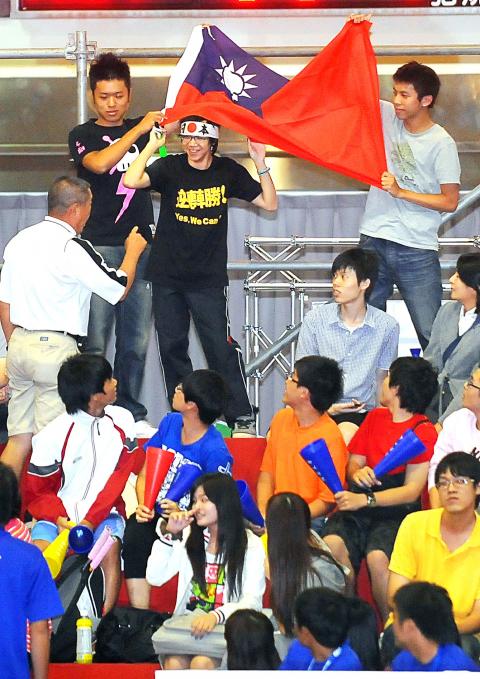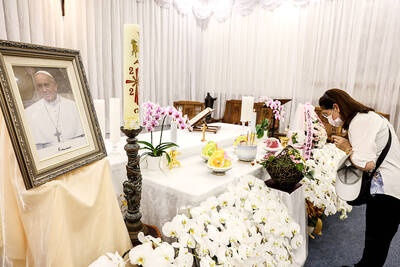An initiative undertaken by Kainan University students yesterday to decorate their campus with Republic of China (ROC) national flags led to a dramatic reaction from a Chinese basketball team, which decided to withdraw from a game it was scheduled to play against a side from Mongolia yesterday afternoon.
Kainan University was the host of this year’s Asian University Basketball Championship, being held in Taoyuan County. Hundreds of ROC national flags were visible from the campus’ parking lots all the way to the bleachers. Upon seeing the flags, a bus carrying the Chinese team left abruptly and the team withdrew.
“We decided to bring in more national flags as a protest against the tournament organizers because we are not satisfied with the way they handled the incident yesterday [Thursday],” said a Kainan University student who declined to be named. “I don’t understand why they stopped us from hanging up our national flags.”

PHOTO: WANG MIN-WEI, TAIPEI TIMES
The student was referring to the incident on Thursday in which spectators were asked to fold up the ROC national flag they were waving at a university basketball game in Taoyuan County in the latest controversy over the display of the flag at international sporting events.
The incident took place when officials of the Chinese Taipei University Sports Federation (CTUSF), the organizer, asked three Kainan University students to take down their meter-high ROC flag at a game between Taiwan University All-Stars and China’s Tianjin Polytechnic University, saying that it was because of a “tacit understanding” with China.
The move immediately sparked outrage from both the students and opposition party lawmakers, who slammed the gesture as “unreasonable” and “disappointing.”
“I’m only half Taiwanese, but whenever I go to international competitions, I always bring the Taiwanese flag,” said Chong Nian-chu (塚念祖), a first-year accounting student at the university. “This competition took place in Taiwan and in our school’s own gymnasium. Why was [I] not allowed to do so?”
Adding that he was also half Japanese, Chong said his intention was originally to express his support for the Taiwanese team. Despite having his flag taken down, Chong insisted that he “definitely had the right” to wave Taiwan’s national symbol.
The week-long competition follows the “Chinese Taipei formula” set up by the International Olympic Committee in 1981.
Under the formula, Taiwanese teams must participate in sporting events under the name “Chinese Taipei” and organizers are not allowed to hang ROC national flags at sporting venues. However, the regulations do not cover spectators.
Information suggests the Chinese team was ready to stop the game and lodge a protest when the three students started to hold up the flag near the end of the third quarter.
The action was promptly stopped by head referee Lee Hung-chi (李鴻棋).
“We didn’t want to wait until the other team protested to dissuade the students. It was done to avoid any unexpected problems,” Lee said.
He later attempted to downplay the incident, saying that he had only “advised” the students to take down the flag because it was getting in the way of other spectators trying to watch the game. Yet picture evidence showed that the flag was held up in the last row of bleachers, well behind any other spectators.
Unconvinced by Lee’s explanation, Democratic Progressive Party Legislator Wong Chin-chu (翁金珠) questioned why Lee “was so afraid of China.”
“It’s completely natural -behavior for the public to wave their own national flag and cheer for their national team at an international competition,” she said, adding that the referee’s behavior was likely influenced by the “continued abandonment of [Taiwan’s] sovereignty by President Ma Ying-jeou’s (馬英九) administration.”
Chen Kuo-yi (陳國儀), the -secretary-general of the Chinese Taipei Olympic Committee, also suggested that Lee could have misread the regulations. He called Lee’s actions “improper” and that Lee’s handling of the incident was incorrect.
“Unless these [regulations] are explicitly written on the tickets of the event or publicly told to spectators, organizers cannot prevent them from holding the national flag in the bleachers,” he said.
In a statement issued yesterday, the Sports Affairs Council said it was a “pity” to learn of the action taken by the officials, describing the handling of the incident by the CTUSF as inappropriate and that it had misinterpreted the “Chinese Taipei” formula.
Vice Minister of Education Lin Tsong-ming (林聰明) said yesterday that although the ministry respects the event organizers, the organizers cannot stop the audience from holding or -waving the national flag unless tickets to the games clearly state that national flags are banned.
“As far as we know, the organizers did not sell any tickets to the championship,” Lin said.
Lin said that the ministry sent an official document to schools yesterday banning them from removing the national flag because of Chinese visitors.
The ministry will punish schools that remove national flags or cancel the singing of the national anthem because of the -presence of Chinese visitors, he said, adding that cross-strait exchanges must be conducted under a principle of equality.
ADDITIONAL REPORTING BY FLORA WANG, CNA AND STAFF WRITER

SECURITY: As China is ‘reshaping’ Hong Kong’s population, Taiwan must raise the eligibility threshold for applications from Hong Kongers, Chiu Chui-cheng said When Hong Kong and Macau citizens apply for residency in Taiwan, it would be under a new category that includes a “national security observation period,” Mainland Affairs Council (MAC) Minister Chiu Chui-cheng (邱垂正) said yesterday. President William Lai (賴清德) on March 13 announced 17 strategies to counter China’s aggression toward Taiwan, including incorporating national security considerations into the review process for residency applications from Hong Kong and Macau citizens. The situation in Hong Kong is constantly changing, Chiu said to media yesterday on the sidelines of the Taipei Technology Run hosted by the Taipei Neihu Technology Park Development Association. With

CARROT AND STICK: While unrelenting in its military threats, China attracted nearly 40,000 Taiwanese to over 400 business events last year Nearly 40,000 Taiwanese last year joined industry events in China, such as conferences and trade fairs, supported by the Chinese government, a study showed yesterday, as Beijing ramps up a charm offensive toward Taipei alongside military pressure. China has long taken a carrot-and-stick approach to Taiwan, threatening it with the prospect of military action while reaching out to those it believes are amenable to Beijing’s point of view. Taiwanese security officials are wary of what they see as Beijing’s influence campaigns to sway public opinion after Taipei and Beijing gradually resumed travel links halted by the COVID-19 pandemic, but the scale of

A US Marine Corps regiment equipped with Naval Strike Missiles (NSM) is set to participate in the upcoming Balikatan 25 exercise in the Luzon Strait, marking the system’s first-ever deployment in the Philippines. US and Philippine officials have separately confirmed that the Navy Marine Expeditionary Ship Interdiction System (NMESIS) — the mobile launch platform for the Naval Strike Missile — would take part in the joint exercise. The missiles are being deployed to “a strategic first island chain chokepoint” in the waters between Taiwan proper and the Philippines, US-based Naval News reported. “The Luzon Strait and Bashi Channel represent a critical access

Pope Francis is be laid to rest on Saturday after lying in state for three days in St Peter’s Basilica, where the faithful are expected to flock to pay their respects to history’s first Latin American pontiff. The cardinals met yesterday in the Vatican’s synod hall to chart the next steps before a conclave begins to choose Francis’ successor, as condolences poured in from around the world. According to current norms, the conclave must begin between May 5 and 10. The cardinals set the funeral for Saturday at 10am in St Peter’s Square, to be celebrated by the dean of the College